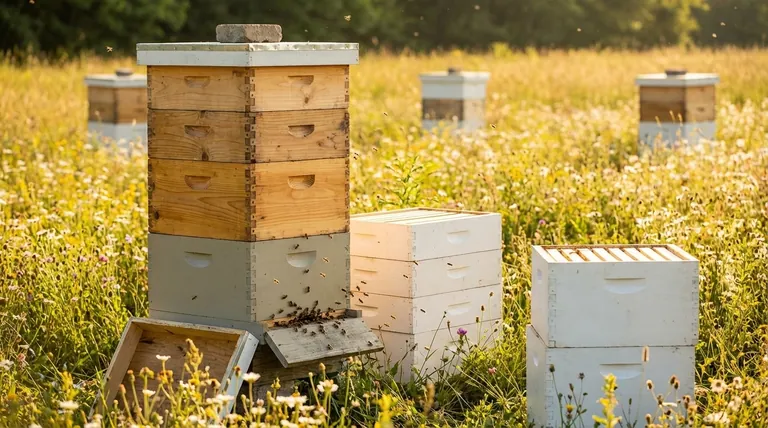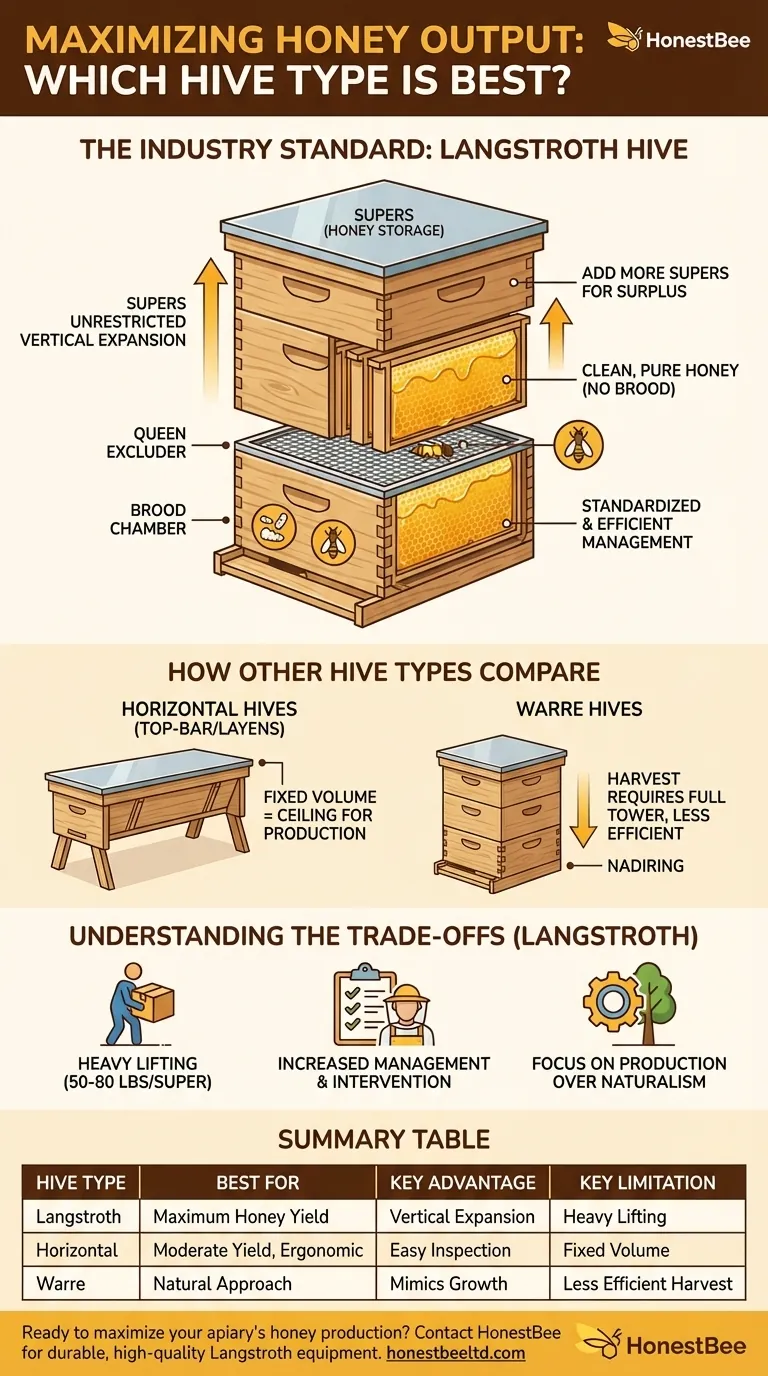For maximizing honey output, the Langstroth hive is the industry standard and the most effective choice. Its modular design allows for near-limitless vertical expansion by adding boxes, known as "supers," which gives the bee colony ample space to store surplus honey. This focus on expandability directly translates to higher honey yields compared to other hive designs.
The core reason the Langstroth hive excels is its design philosophy: it separates the queen's brood chamber from dedicated honey storage boxes (supers). This allows a beekeeper to expand honey storage capacity indefinitely without disrupting the colony's core functions, channeling the bees' efforts directly into production.

Why the Langstroth Design Maximizes Yield
The Langstroth hive's effectiveness isn't accidental; it's the result of specific design features working in concert to encourage honey production.
Unrestricted Vertical Expansion
The defining feature of a Langstroth hive is its stackable, modular nature. As the colony gathers more nectar than it needs, you can simply add a new super (a box of frames) on top.
Bees naturally store honey above their brood nest. The Langstroth system leverages this instinct by providing a clear, upward path for expansion, preventing the colony from feeling "honey bound" and triggering a swarm.
The Power of the Queen Excluder
A queen excluder is a simple screen with gaps large enough for worker bees but too small for the queen.
Placing this between the lower brood boxes and the upper honey supers ensures the queen cannot lay eggs in the honey frames. This results in pure, clean honey that is easy to harvest without worrying about damaging brood.
Standardized and Efficient Management
Langstroth hives use standardized dimensions for boxes and frames. This uniformity is a massive advantage for any beekeeper focused on production.
Parts are interchangeable, widely available, and compatible with honey extraction equipment like centrifugal spinners. This streamlines every part of the process, from inspection to harvest, saving significant time and labor.
How Other Hive Types Compare
While other hives are excellent for different goals, their designs present inherent limitations for maximizing honey collection.
Horizontal Hives (Top-Bar and Layens)
These hives expand horizontally rather than vertically. The total volume of the hive is fixed, and bees build their comb down from simple bars.
While they are excellent for beekeepers who want to avoid heavy lifting, this fixed-volume design creates a natural ceiling for honey production. Management for honey can be more complex, sometimes requiring internal divisions rather than simply adding a box.
Warre Hives
Warre hives also expand vertically, but new boxes are typically added to the bottom of the stack, a process called "nadiring."
This method more closely mimics how a bee colony grows in a natural tree cavity and is excellent for colony health and overwintering. However, for honey harvesting, it is less efficient as you must wait for the bees to fill the entire tower before you can take the top box.
Understanding the Trade-offs
The Langstroth's focus on production comes with clear trade-offs that are important to acknowledge.
The Cost of Production: Heavy Lifting
A Langstroth super filled with honey can weigh between 50 and 80 pounds (22-36 kg). Managing a tall stack of these boxes requires significant physical strength.
Increased Management and Intervention
To effectively prevent swarming and maximize yield, a Langstroth hive requires regular inspections to determine when to add more space. It is a more interventionist system compared to more hands-off approaches.
A Focus on Production Over Naturalism
The entire system—from the movable frames to the queen excluder—is designed to manipulate the colony's behavior for human benefit. Beekeepers prioritizing a more "natural" or treatment-free philosophy may find other hive types better align with their values.
Making the Right Choice for Your Goal
Your choice of hive should be a direct reflection of your primary objective as a beekeeper.
- If your primary focus is maximum honey yield for commercial or large-scale hobbyist purposes: The Langstroth hive is the undisputed choice due to its scalability and efficiency.
- If your primary focus is a moderate honey yield with minimal heavy lifting: A horizontal hive like a Top-Bar or Layens is a superior ergonomic choice, though it will produce less honey.
- If your primary focus is balancing honey production with a more "natural" beekeeping approach: The Warre hive offers a compromise, though it requires a different management style for harvesting.
Ultimately, aligning your equipment with your specific production goals is the foundation of a successful and rewarding beekeeping journey.
Summary Table:
| Hive Type | Best For | Key Advantage | Key Limitation |
|---|---|---|---|
| Langstroth | Maximum Honey Yield | Unrestricted vertical expansion with supers | Requires heavy lifting and regular management |
| Horizontal (Top-Bar/Layens) | Moderate Yield, Minimal Lifting | Ergonomic, easy inspection | Fixed volume limits total honey production |
| Warre | Natural Beekeeping Approach | Mimics natural colony growth | Less efficient harvesting process |
Ready to maximize your apiary's honey production?
As a leading wholesale supplier to commercial apiaries and distributors, HONESTBEE provides the durable, high-quality Langstroth equipment you need to scale your operation efficiently. Our hive components are built for productivity and longevity, helping you achieve higher yields season after season.
Contact our expert team today to discuss your commercial beekeeping supply needs and request a wholesale catalog.
Visual Guide

Related Products
- Long Langstroth Style Horizontal Top Bar Hive for Wholesale
- Telescopic Beehive Outer Cover Lid Roof with Galvanised Sheeting for Langstroth Hive and Beehive Outer Cover
- Professional Hive Top Bee Feeder for Beekeeping
- HONESTBEE Professional Multi-Functional Hive Tool with Ergonomic Wood Handle
- HONESTBEE Advanced Ergonomic Stainless Steel Hive Tool for Beekeeping
People Also Ask
- How does the design of a top bar hive benefit beekeepers? Ergonomic & Natural Beekeeping for Hobbyists
- What are the advantages of a top bar hive? Simpler, Bee-Centric Beekeeping for All
- What are the benefits of the top bar hive? A Guide to Ergonomic, Natural Beekeeping
- What are the most popular types of hives besides the Langstroth? Top Bar & Horizontal Hives Explained
- What are the benefits of a top bar hive? A Natural, Low-Impact Approach to Beekeeping



















